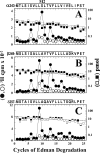Multiple transmembrane binding sites for p-trifluoromethyldiazirinyl-etomidate, a photoreactive Torpedo nicotinic acetylcholine receptor allosteric inhibitor
- PMID: 21498509
- PMCID: PMC3121496
- DOI: 10.1074/jbc.M111.219071
Multiple transmembrane binding sites for p-trifluoromethyldiazirinyl-etomidate, a photoreactive Torpedo nicotinic acetylcholine receptor allosteric inhibitor
Abstract
Photoreactive derivatives of the general anesthetic etomidate have been developed to identify their binding sites in γ-aminobutyric acid, type A and nicotinic acetylcholine receptors. One such drug, [(3)H]TDBzl-etomidate (4-[3-(trifluoromethyl)-3H-diazirin-3-yl]benzyl-[(3)H]1-(1-phenylethyl)-1H-imidazole-5-carboxylate), acts as a positive allosteric potentiator of Torpedo nACh receptor (nAChR) and binds to a novel site in the transmembrane domain at the γ-α subunit interface. To extend our understanding of the locations of allosteric modulator binding sites in the nAChR, we now characterize the interactions of a second aryl diazirine etomidate derivative, TFD-etomidate (ethyl-1-(1-(4-(3-trifluoromethyl)-3H-diazirin-3-yl)phenylethyl)-1H-imidazole-5-carboxylate). TFD-etomidate inhibited acetylcholine-induced currents with an IC(50) = 4 μM, whereas it inhibited the binding of [(3)H]phencyclidine to the Torpedo nAChR ion channel in the resting and desensitized states with IC(50) values of 2.5 and 0.7 mm, respectively. Similar to [(3)H]TDBzl-etomidate, [(3)H]TFD-etomidate bound to a site at the γ-α subunit interface, photolabeling αM2-10 (αSer-252) and γMet-295 and γMet-299 within γM3, and to a site in the ion channel, photolabeling amino acids within each subunit M2 helix that line the lumen of the ion channel. In addition, [(3)H]TFD-etomidate photolabeled in an agonist-dependent manner amino acids within the δ subunit M2-M3 loop (δIle-288) and the δ subunit transmembrane helix bundle (δPhe-232 and δCys-236 within δM1). The fact that TFD-etomidate does not compete with ion channel blockers at concentrations that inhibit acetylcholine responses indicates that binding to sites at the γ-α subunit interface and/or within δ subunit helix bundle mediates the TFD-etomidate inhibitory effect. These results also suggest that the γ-α subunit interface is a binding site for Torpedo nAChR negative allosteric modulators (TFD-etomidate) and for positive modulators (TDBzl-etomidate).
Figures










References
Publication types
MeSH terms
Substances
Grants and funding
LinkOut - more resources
Full Text Sources
Other Literature Sources

